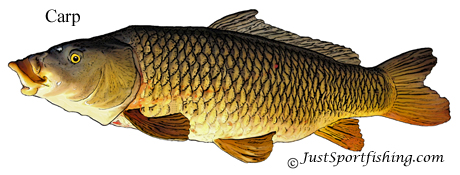|
|

How
to fish for Carp
Common carp are native to Asia and Eastern Europe. It has been introduced into environments worldwide, and is often considered an invasive species. Although they are very tolerant of most conditions, common carp prefer large bodies of slow or standing water and soft, vegetative sediments. A schooling fish, they prefer to be in groups of 5 or more. Common carp are extremely popular with anglers in many parts of Europe and their popularity as a game fish is slowly increasing among anglers in the United States.
Ways of detecting possible areas that hold carp is looking at a lake's visible features. The most common areas of a lake or pond where carp may be holding are Islands, Weed beds, Lilly pads, Reed rush beds, Overhanging trees, Snags, or in Shallows. Carp angling is very much a waiting game. It involves a lot of patience and being able to cover as large an area of water as possible. Because of this many carp fishermen fish two rods at a time.
For an all round Carp rod that will be sufficient for many different bodies of water an 11 foot 1 ½ to 2 lb test curve medium action fishing rod with a matching baitrunner or spincasting reel spooled with 10 Lb. test monofilament or braided line. A shock leader should be used in sizes from 15 lb to 40 lb test depending on the distance cast and the size of the weight used. Carry a variety of barbless hooks in sizes 12 to 4, these will cover a variety of fishing situations. For Carp fishing, the main two types of weights are the in-line and the bomb type, a selection of both types from 1 to 3 oz. should be kept in your tackle box.
There are many commercially available baits on the market today as well as particle baits that can be found at your local grocery store and natural baits that can be found in the local lake or river that you are going to fish. These baits can be used in a variety of set ups including the Hair rig, Pop-up Rig, blowback rig, stiff rig, D rig, combi rig, greedy pig rig, Helicopter Rig, and the running rig.
Traditionally bait had been placed directly onto a hook, whether it is a dough bait that completely surrounds the hook or a kernel or two of sweet corn that is pierced by the hook point and mounted onto the shank of the hook.
The Hair Rig is a Carp rig that appeared in the late 1970's. The name comes from the material by which the bait was originally attached to the hook, not being directly pierced by the hook itself, the bait was mounted on a piece of human hair that was attached to the hook so there was no association with a hook-length material and the bait presented, by the feeding Carp. The rig was devised out of necessity as Carp were quick to associate danger with both the feeling of monofilament line within the mouth and a presented bait that did not react naturally when being investigated. During the test the Carp would pick up all of the free offerings and completely ignore the baited hook. A simple Hair Rig can be tied using any form of hook length material with a Knotless knot. The bait is mounted on the Hair so that it sits away from the hook and the length of the hair can be adjusted to suit the various fishing conditions. You will find that at some waters a longer hair will work better than a shorter one, depending on how the fish are feeding.

|
JustSportfishing.com

|


